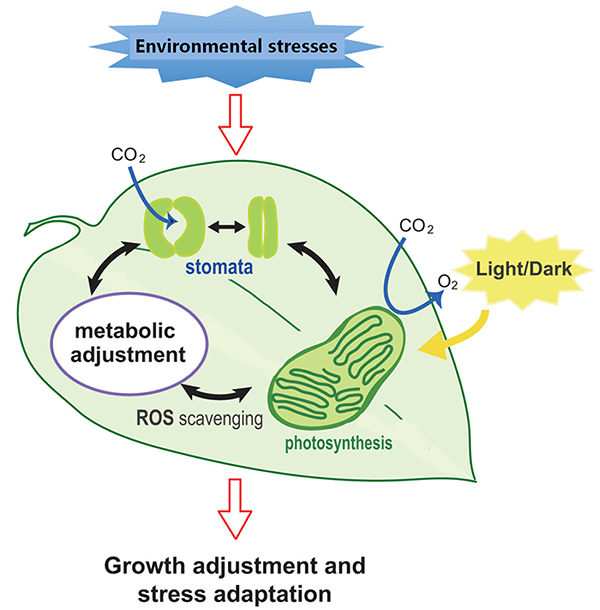Plant stress responses refer to the various molecular and cellular processes triggered by different types of stresses. These stresses can be abiotic (e.g., water, salinity, extreme temperature, light, heavy metal contamination) or biotic (herbivores or pathogens). Plants respond to adverse environmental conditions by the regulation of specific biological processes and pathways, such as photosynthesis, plant cell signaling, and plant secondary metabolism (Figure 1). Analysis of plant stress response and the corresponding tolerance mechanisms is not only important for basic plant biological researches, but also pivotal for agricultural crop improvement.
With years of experience in plant physiological studies, Lifeasible offers a wide array of analytical services for the characterization of plant physiological traits under stresses. These physiological traits include photosynthesis and water use related traits, phytohormones, plant pigments, as well as plant stress response indicators (e.g., leaf photosynthesis efficiency and electroconductivity, antioxidant enzymes, malondialdehyde, proline, soluble sugar and starch, soluble protein, etc.).
 Figure 1. Illustration of environmental stress response of plants (modified from Osakabe et al., 2013)
Figure 1. Illustration of environmental stress response of plants (modified from Osakabe et al., 2013)
Leaf Photosynthesis Efficiency and Electroconductivity Analysis
The photosynthetic efficiency of photosystem II will decrease under environmental stresses. The light (ΔF/Fm’) or the dark-adapted state (Fv/Fm) photosynthetic efficiency, as well as the electron transport rate (ETR) can help us to evaluate the degree of plant stress. In addition, the membrane permeability will change to increase the electrolyte leakage under stresses.
Antioxidant Enzymes Activity Analysis
Under oxidative stresses, reactive oxygen species (ROS), such as superoxide radicals (O2−), singlet oxygen (1O2), hydrogen peroxide (H2O2) and hydroxyl radicals (OH−), will accumulate in plant cells, which can cause damage to lipids, proteins, and DNAs. To cope with this damage, The plant has evolved to produce multiple antioxidant enzymes. We provide activity analysis of a variety of antioxidant enzymes including catalase, superoxide dismutase, peroxidase, and so on.
Malondialdehyde Content Measurement
Malondialdehyde (MDA) is an organic compound with the nominal formula of CH2 (CHO)2. MDA is produced by lipid peroxidation of polyunsaturated fatty acids. The content of MDA can be measured by thiobarbituric acid (TBA) reactive substances assay, dinitrophenyl hydrazine (DNPH) assay, and pentafluorobenzyl (PFB) bromide assay.
Proline content can increase upon exposure of plants to drought, salinity, cold, heavy metals, or certain pathogens. Determination of proline levels can help monitor physiological status, and to assess stress tolerance in higher plants. At Lifeasible, our experts offer multiple solutions for proline concentration evaluation, including acid-ninhydrin method, fluorescamine method, fluorescence competition method, isatin paper assay, high performance liquid chromatography (HPLC) method, together with the optical method.
Soluble Sugar and Starch Content Measurement
The soluble sugars and other carbohydrates in the leaves of stressed plants are altered in quantity and quality. The changes of sugars content may act as a metabolic signal in response to osmotic stresses. Many different techniques have been used to measure the content of sugars, including colorimetric method, colorimetric method, titration method, and HPLC method.
Soluble Protein Content Measurement
The accumulation of soluble proteins is also a mechanism employed by plants to response to environmental stresses. Lifeasible has developed many methods to determine soluble protein content, such as direct spectrometry measurement at 280 nm, Bradford method, Kjeldahl method, enhanced Dumas method, as well as Lowery method.
Lifeasible is one of a few companies who provide solutions for a comprehensive plant stress response indicators analysis. After many years in serving companies and research institutes, we have demonstrated the high reliability of our services and can ensure the success of your project. For more information, please contact us.
Reference
Lifeasible has established a one-stop service platform for plants. In addition to obtaining customized solutions for plant genetic engineering, customers can also conduct follow-up analysis and research on plants through our analysis platform. The analytical services we provide include but are not limited to the following:
Get Latest Lifeasible News and Updates Directly to Your Inbox
Adaptive Evolutionary Mechanism of Plants
February 28, 2025
Unraveling Cotton Development: Insights from Multi-Omics Studies
February 27, 2025